Francis Davis Millet stands as a remarkable figure in the landscape of American art and culture during the late 19th and early 20th centuries. More than just a painter, Millet was a sculptor, writer, journalist, and influential arts administrator whose life, marked by diverse achievements and a wide circle of prominent friends, was tragically cut short in the sinking of the RMS Titanic. His career reflects the ambitious spirit of the Gilded Age, a period of immense industrial growth and cultural aspiration in the United States, where artists often played public roles in shaping the nation's aesthetic and intellectual identity. Millet's dedication to academic precision, his embrace of historical and classical themes, and his tireless work in organizing and promoting American art both at home and abroad cemented his legacy as a pivotal, if sometimes overlooked, contributor to his era.
Early Life and Formative Artistic Training
Born on November 3, 1846, in Mattapoisett, Massachusetts, Francis Davis Millet's early life was imbued with the industrious spirit of New England. His father, Asa Millet, was a physician. The outbreak of the American Civil War saw a young Millet enlist, serving first as a drummer boy with the 60th Massachusetts Infantry and later as a surgical assistant to his father. This early exposure to the realities of conflict and human suffering would subtly inform his later work as a war correspondent and perhaps his meticulous attention to detail.
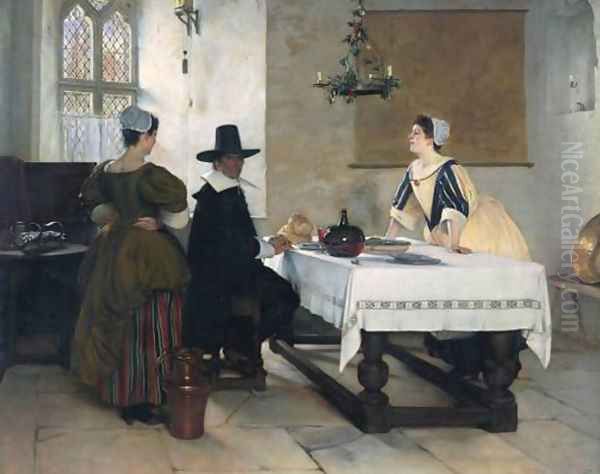
Following the war, Millet pursued a literary education at Harvard University, graduating with a Bachelor of Arts in 1869 and later a Master of Arts in literature. His intellectual curiosity was broad, but the visual arts soon claimed his primary focus. Recognizing his burgeoning talent, he traveled to Europe to immerse himself in classical and contemporary artistic traditions. His destination was the prestigious Royal Academy of Fine Arts in Antwerp, Belgium, a bastion of academic training. There, he studied under notable figures such as Hendrik Leys and Joseph van Lerius, honing his skills in draughtsmanship, composition, and the historical genre. Millet excelled, winning a silver medal in his first year and a gold medal in his second, a testament to his dedication and rapidly developing prowess. This European sojourn was crucial, connecting him with the rich artistic heritage that would deeply influence his style.
The Ascendance of an Academic Realist
Upon returning to the United States in the early 1870s, Millet began to establish himself professionally. He initially worked as a lithographer for the "Boston Advertiser." His European training, steeped in the academic tradition, emphasized meticulous realism, historical accuracy, and carefully constructed compositions. This contrasted with the burgeoning Impressionist movement, championed by artists like Claude Monet and Camille Pissarro in France, and later by American counterparts such as Childe Hassam and Mary Cassatt. While Millet respected various artistic approaches, his own inclinations remained firmly rooted in the narrative clarity and technical polish of academic art, a style favored by many patrons and institutions of the Gilded Age.
His early paintings often depicted historical scenes, classical allegories, and detailed genre subjects. He shared this affinity for historical and literary themes with contemporaries like Edwin Austin Abbey, with whom he would later share a close friendship and artistic community in Broadway, England. Millet's work was characterized by its smooth finish, precise rendering of textures and costumes, and a certain quiet dignity in its figures. He was a master of conveying narrative through carefully chosen details and gestures, inviting viewers to engage with the stories unfolding on his canvases.
A Versatile Career: Painting, Murals, and Beyond
Francis Davis Millet's artistic output was remarkably diverse. While he produced numerous easel paintings, he also became a highly sought-after muralist, contributing to the decoration of significant public buildings. The late 19th century saw a renaissance in mural painting in America, fueled by a desire to adorn new civic and commercial structures with art that conveyed national pride, historical narratives, and allegorical virtues. Millet was at the forefront of this movement, alongside artists such as John La Farge, Kenyon Cox, and Edwin Howland Blashfield.
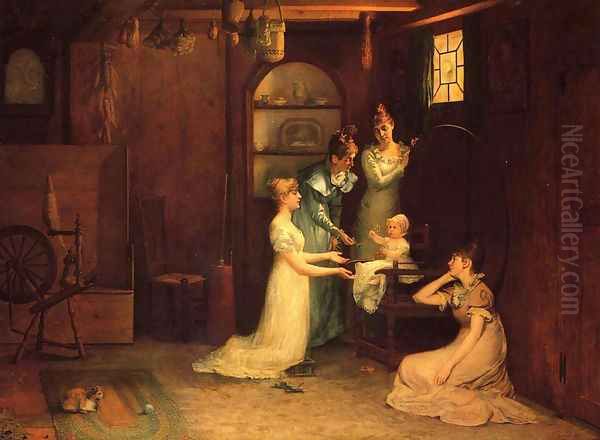
One of his notable early mural commissions was for the Custom House in Baltimore, where he depicted scenes related to commerce and maritime history. He also created significant murals for the Minnesota State Capitol, including "The Treaty of Traverse des Sioux," and the Federal Building in Cleveland, with works like "The History and Settlement of Ohio." These large-scale projects demanded not only artistic skill but also considerable organizational ability, as they often involved coordinating with architects and other artists. His mural Thesmophoria, depicting an ancient Greek festival in honor of Demeter and Persephone, showcased his classical knowledge and ability to render complex multi-figure compositions with grace and historical verisimilitude.
Beyond murals, his easel paintings continued to garner acclaim. Between Two Fires (1892), now in the Tate Britain collection, is perhaps his most famous genre painting. It depicts a Puritan man seated at a table, caught between the stern gaze of a woman to his left and the enticing smile of a serving maid offering him a drink to his right. The painting is a masterclass in subtle psychological drama, rendered with exquisite detail in the depiction of the 17th-century interior and costumes. Another notable work, An Autumn Idyll (1892), captures a serene classical scene, reflecting his enduring interest in antiquity. His portraiture, such as the Portrait of Charles Francis Adams, Jr., demonstrated his ability to capture not just a likeness but also the character of his sitters. Playing with Baby is another example of his tender genre scenes, showcasing a more intimate side of his artistic vision.
The Writer and War Correspondent
Millet's talents were not confined to the visual arts. He was also an accomplished writer and journalist. His literary pursuits included translating Leo Tolstoy's Sebastopol Sketches from Russian into English, a task that underscored his linguistic abilities and interest in diverse cultures. He authored numerous short stories and travel essays, often drawing on his extensive journeys.
His adventurous spirit led him to serve as a special correspondent for several newspapers, including the London Daily News, the London Graphic, and Harper's Weekly, during the Russo-Turkish War (1877-1878). His vivid dispatches from the front lines earned him considerable recognition and decorations from both the Russian and Romanian governments for his bravery and insightful reporting. He later covered the Spanish-American War in the Philippines, further demonstrating his courage and journalistic acumen. These experiences provided him with a wealth of material and a unique perspective that undoubtedly enriched his worldview and, indirectly, his art.
An Influential Arts Administrator and Organizer
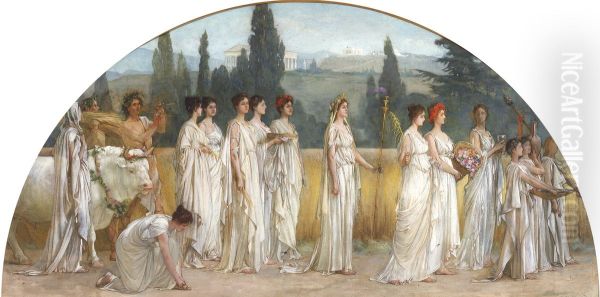
Francis Davis Millet possessed a remarkable talent for organization and leadership, which he applied to numerous artistic and cultural endeavors. He played a significant role in the American art world as an administrator and advocate. He was instrumental in the decorations for the World's Columbian Exposition in Chicago in 1893, serving as Director of Decorations and collaborating with a team of prominent artists and architects, including Daniel Burnham and Augustus Saint-Gaudens. This exposition was a landmark event, showcasing American artistic and industrial achievement to the world, and Millet's role was pivotal in its visual success. Many artists, including Mary Cassatt and Mary Fairchild MacMonnies Low, contributed significant murals under his general direction.
Millet was a founding member of the American Federation of Arts and served as its secretary. He was also deeply involved with the National Academy of Design, where he was elected a full Academician in 1885. Furthermore, he was a key figure in the establishment and administration of the American Academy in Rome, serving as its secretary. This institution, founded by figures like the architect Charles Follen McKim, aimed to provide American artists and scholars with opportunities to study classical traditions in situ. Millet's dedication to these organizations highlights his commitment to fostering a vibrant and internationally respected American art scene. He also designed the Civil War Campaign Medal for the U.S. Army in 1907 and the Spanish Campaign Medal in 1908.
Friendships and the Broadway Colony
Millet was known for his affable personality and cultivated a wide circle of friends, many of whom were leading figures in the arts and letters. He was particularly close to the celebrated portraitist John Singer Sargent. Together with Edwin Austin Abbey, they formed the nucleus of an Anglo-American artistic community in the picturesque village of Broadway in the Cotswolds, England, during the 1880s. This idyllic setting became a haven for artists and writers, including Henry James and later, Mark Twain, who was a close friend of Millet. The atmosphere at Broadway was one of creative camaraderie, with artists sharing ideas, painting landscapes and each other, and enjoying a somewhat bohemian lifestyle.
Millet's home in Broadway, Russell House, and later Abbot's Grange, became central to this artistic circle. His organizational skills extended to managing these often lively households and social gatherings. His wife, Elizabeth "Lily" Greely Merrill, whom he married in 1879, was also an integral part of this vibrant community. They had several children, including a son, Laurence Frederick Millet, who also became an artist. The friendships forged during this period were lifelong and deeply influential on the participants' work and careers.
Personal Life and Complex Relationships
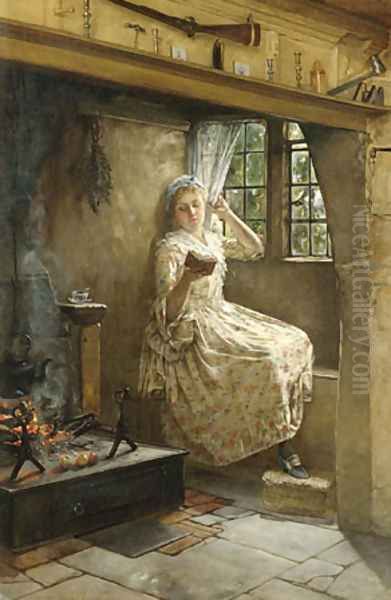
While Millet maintained a conventional family life with his wife Lily and their children, some modern scholarship, notably by art historian H. Barbara Weinberg, has explored the nature of his close relationships with other men, including the writer Charles Warren Stoddard and, later, Major Archibald Butt, military aide to Presidents Roosevelt and Taft. These relationships, often characterized by intense emotional bonds and shared experiences, were not uncommon in the 19th century, a period with different social mores regarding expressions of male affection. Interpreting these relationships through a contemporary lens requires careful consideration of historical context. What is clear is that Millet was capable of forming deep and meaningful connections with a diverse range of individuals.
The Tragic End: The Titanic Disaster
In April 1912, Francis Davis Millet was returning to the United States from Europe aboard the RMS Titanic. He was traveling with his close friend, Major Archibald Butt. Millet was on his way to Washington D.C. for a meeting of the National Academy and to attend the annual convention of the American Federation of Arts in his capacity as secretary. The Titanic, on its maiden voyage, struck an iceberg on the night of April 14th and sank in the early hours of April 15th.
Accounts from survivors paint a picture of Millet's calm and bravery in the face of disaster. He was reportedly last seen helping women and children into lifeboats, working alongside Butt. Both men perished in the sinking. Millet was 65 years old. His body was later recovered by the cable ship Mackay-Bennett and was identified by the distinctive clothing and items he wore. He was buried in Central Cemetery, East Bridgewater, Massachusetts.
The news of his death sent shockwaves through the art worlds of America and Europe. He was widely mourned as a talented artist, a dedicated public servant in the arts, and a cherished friend. Memorials were erected in his honor, including the Butt-Millet Memorial Fountain located near the White House in Washington, D.C., dedicated to both men, and a memorial in the South-West Transept of Ely Cathedral in England, near his English home.
Legacy and Lasting Influence
Francis Davis Millet's legacy is multifaceted. As a painter and muralist, his work exemplifies the high standards of academic realism prevalent during the Gilded Age. His historical scenes, classical compositions, and genre paintings are characterized by their technical skill, narrative clarity, and meticulous detail. Works like Between Two Fires remain popular and are frequently studied for their artistic merit and cultural insights. His murals adorn important public buildings, contributing to the "American Renaissance" aesthetic that sought to beautify civic spaces and instill cultural values.
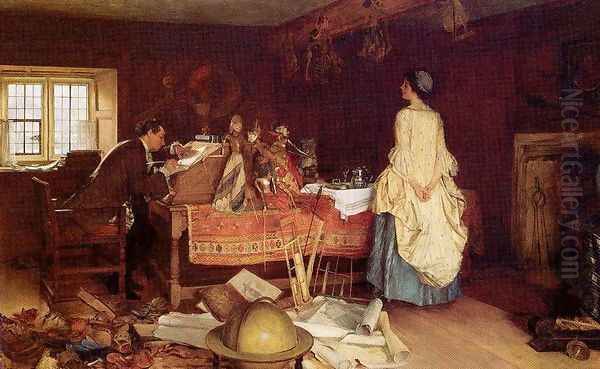
Beyond his artistic creations, Millet's contributions as an arts administrator and organizer were profound. His work with the World's Columbian Exposition, the American Federation of Arts, and the American Academy in Rome helped to shape the infrastructure of the American art world, promoting professionalism, education, and international exchange. He was a bridge-builder, connecting artists, patrons, and institutions.
His life as a writer and war correspondent adds another dimension to his remarkable persona, showcasing his adventurous spirit and intellectual curiosity. The tragic circumstances of his death on the Titanic have, for many, overshadowed his diverse accomplishments, yet they also serve as a poignant reminder of a life lived with vigor, purpose, and a deep commitment to art and public service. Francis Davis Millet remains an important figure for understanding the artistic and cultural currents of his time, a testament to the power of a life dedicated to beauty, knowledge, and community. His works are held in major collections, including the Metropolitan Museum of Art in New York, the Tate Britain in London, and the National Gallery of Art in Washington, D.C., ensuring that his artistic vision continues to be appreciated by future generations.